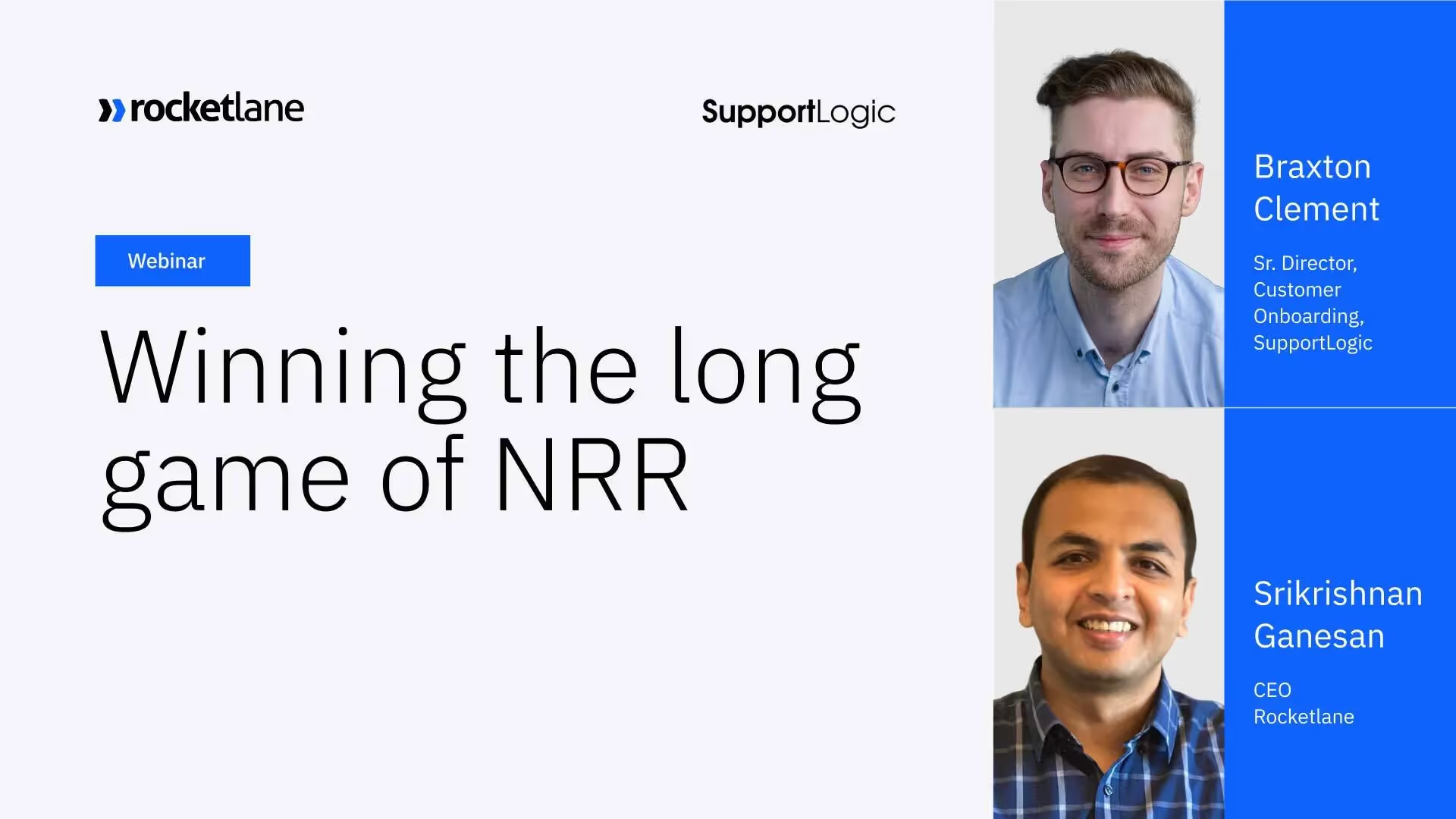It’s easier to grow your business when you don’t lose revenue with every new customer.
What’s easier?
Increasing your net revenue from existing customers over time. It’s what makes Net Revenue Retention (NRR) such a game-changer for growing your business.
In this webinar, Braxton Clement from SupportLogic and Srikrishnan Ganesan from Rocketlane share tips and tricks for winning the long game of NRR and discuss:
- The connection between customer experience and NRR
- How retention and expansion start with customer onboarding
- Common drivers of NRR
- How you can engineer NRR by managing customer onboarding, adoption, and engagement
- Leveraging support signals to deliver stellar CX
and more.
Here are the key takeaways from the session.
The connection between customer experience and NRR
When customers use your product, they don’t just judge your product, they judge the overall experience with your company and their partnership with you.
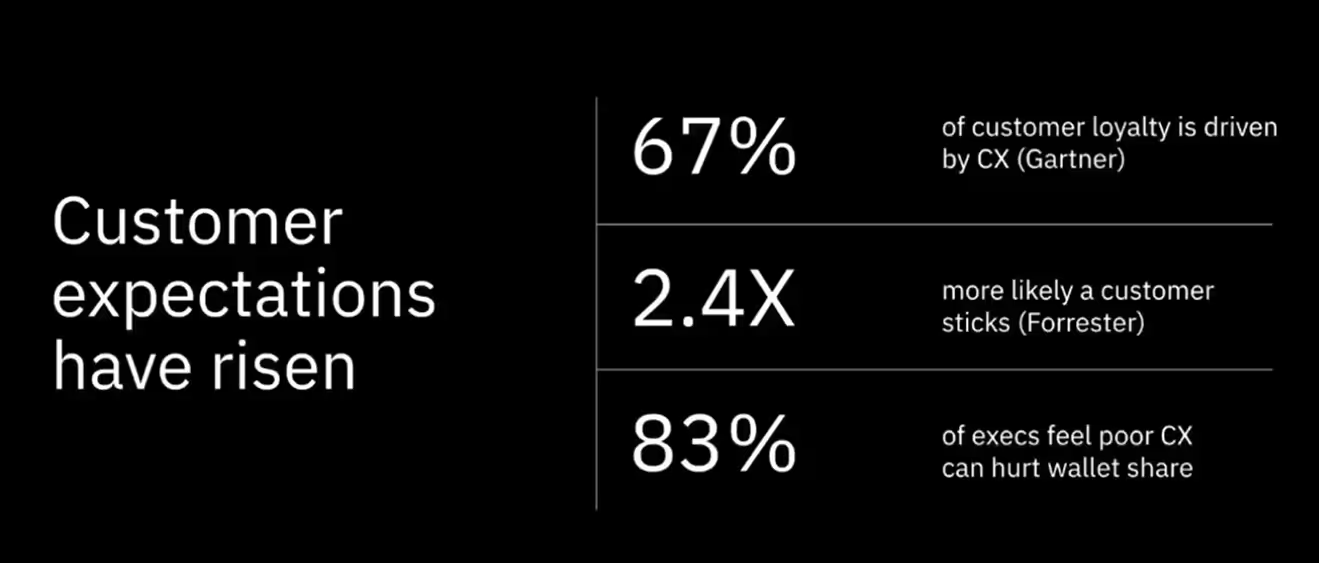
Improving CX has a direct impact on your revenue.
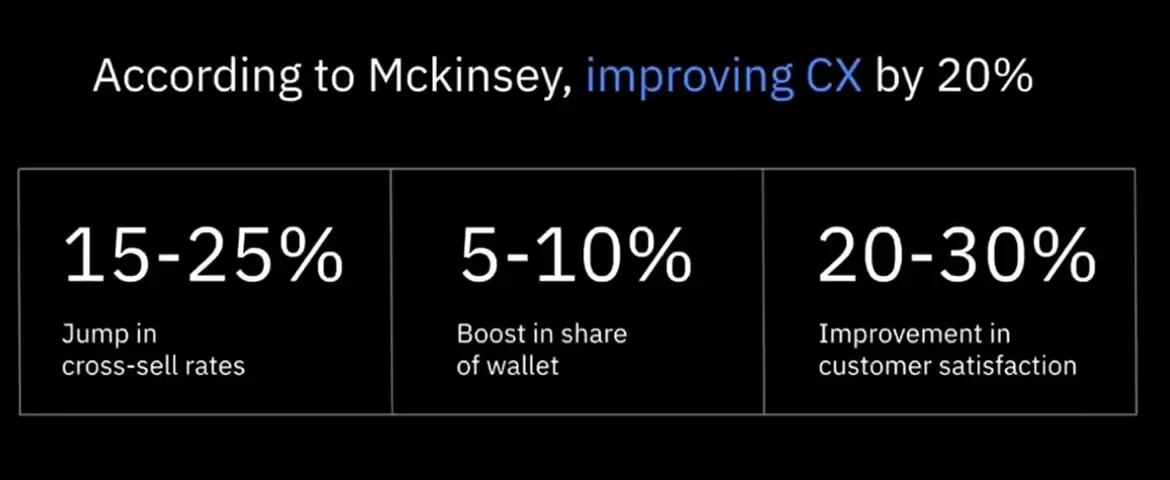
You need to work with your team to design new experiments and experiences to create wow moments for your customers.
For inspiration, check out Airbnb’s 11-star experience model for designing experiences that your customers will want to talk about. The model focuses on thinking about what a 5-star experience looks like for your customer and extrapolating that to 11 stars.
While an 11-star experience might not always be feasible, this model can help you brainstorm what a great experience for your customers could look like.
Customer onboarding's role in sustaining momentum and continued discovery
Customer onboarding marks the first interaction and collaboration between your team and the customer. Ensuring a positive experience is paramount, as it lays the foundation for a successful partnership. Customer onboarding done right can foster increased engagement and interest from the customer, encouraging them to seek additional interactions with your team.
Effective customer onboarding should go beyond product implementation; it should sustain the momentum generated during the sales process, often spanning several months.
You also need to look at customer onboarding as a continuation of the discovery process.
By establishing rapport and asking the right questions, you can uncover insights that lead you and your customers to a much bigger picture. Here are a few questions to continue the discovery process:
- Can customers use the product in ways beyond those discussed in the initial sales cycle?
- Are there other groups or business units within their organization that might be a good fit?
- Are there cross-sell opportunities that could augment the customer’s current use case?
It’s important to bring up these questions during customer onboarding due to limitations (timing, budget constraints) or different circumstances (key decision-makers missing) that might have existed during the sales process.
How retention and expansion start with customer onboarding
While the seeds for expansion are planted during customer onboarding, expansion itself can happen during onboarding.
Srikrishnan shared an example of this from Rocketlane’s experience with a big-ticket customer. They dedicated on-site resources to collaborate extensively with the customer to:
- Channel the initial enthusiasm and momentum
- Build trust and belief in the partnership
The result was a $120K expansion before the scheduled go-live date!
SupportLogic also experienced the impact of effective customer onboarding on expansion. By adopting Rocketlane for customer onboarding, they were able to reduce their time-to-go-live from 112 days to 42. In 2022, 61% of their expansion revenue came from customers who had just completed their first term (right after onboarding). This number jumped to 77% in 2023 – post the improvements in their customer onboarding process.
In another case, a company conducted an experiment where they offered customer onboarding services to a few customers, while the rest were asked to self-serve their onboarding.
Their data showed that using their team for customer onboarding led to a 4x improvement – twice the expansion, in half the time.
This ties into another important point: measure your initiatives and how they impact renewals, customer experience, attach rate of other products, how early expansion happens, etc.
Understanding these numbers and measuring them is critical to justify the value of what you do – especially in today’s economic climate,
Decomposing NRR: The common drivers of NRR
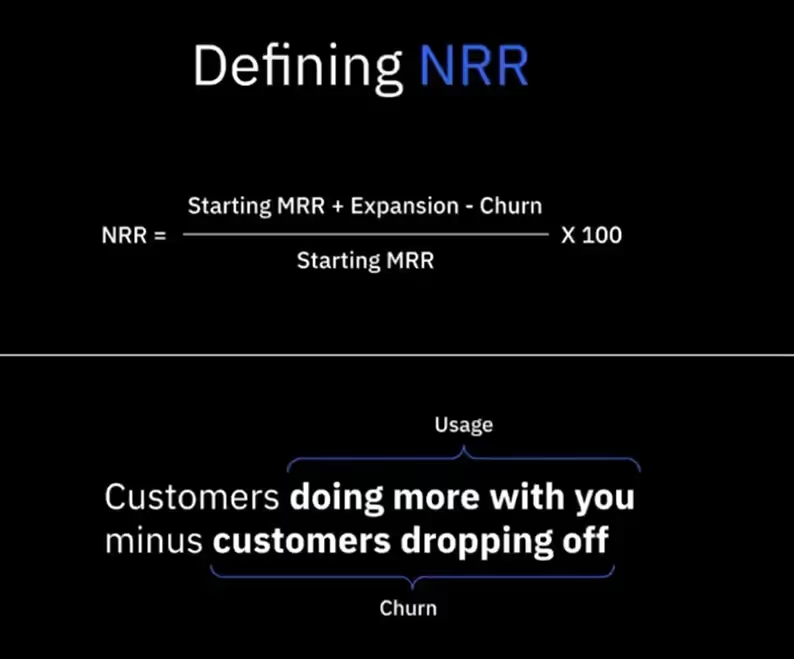
In typical scenarios, a healthy NRR sits around 110 for most businesses, while top-tier companies might even achieve 170. For consumption-driven enterprises, an NRR of around 170 is feasible as they expand.
Even if your model is primarily seed-based, aiming for a range of 100 to 120 is advisable, given the current market conditions.
The two questions at the heart of engineering NRR
The key to engineering NRR is asking yourself:
- How are you reducing the churn or minimizing customers dropping off?
- How are you expanding – or encouraging customers to do more with you?
We need to dig deeper into churn and expansion to answer these questions.
Here are the top four reasons for churn.

- Bad product-customer fit: When customers fail to their goals because It was the wrong sell)
- Ineffective onboarding process: Often a result of going through the motions during customer onboarding and defaulting to a checklist-based approach for it. It could also happen when customer onboarding teams optimize too much for time to value, without understanding what the customer really needs and using that to customize their journey
- Poor customer experience: When customers have a bad first impression that's hard to recover from
- Value gap: Often because onboarding failed to provide value to the customer. But it could also be because the customer doesn't recognize or acknowledge the value provided. This could be because they weren't benchmarking or measuring before, or that their definition of value is different from the vendor's, or that the customer champions are unable to articulate value to their leadership effectively.

Pre-requisites for customer expansion and the ‘expansion avalanche’
Here are the pre-requisites for expansion:
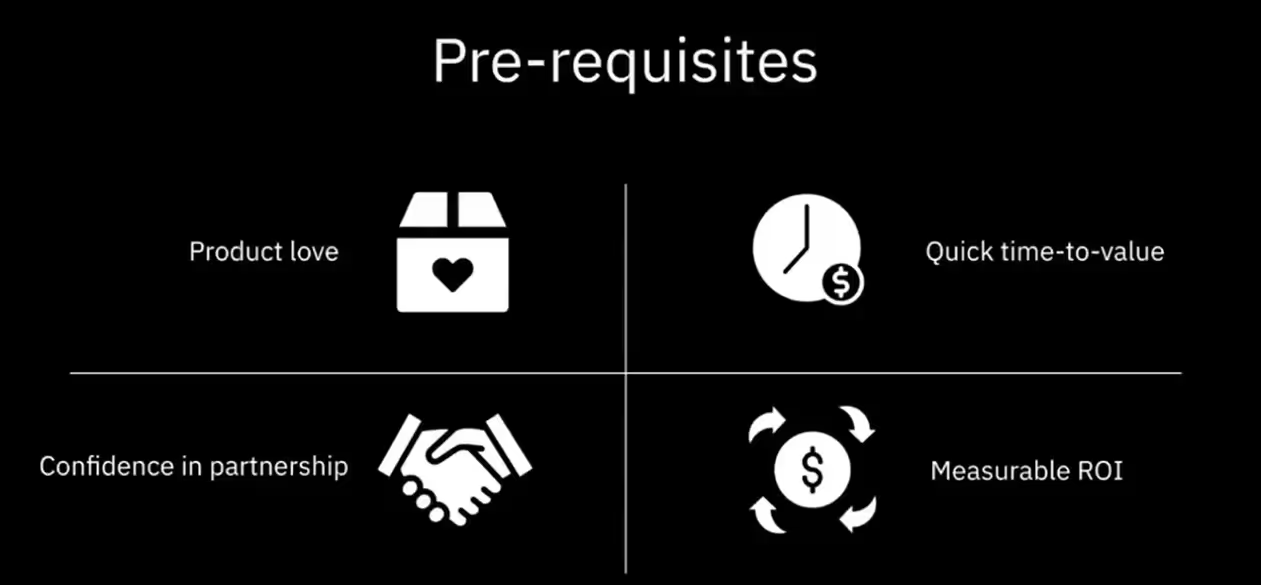
- Product love: You need customers to like using your product, enough for them to want to do more with it. This is especially important in the current difficult business environment because setting the basics right in a hard year is going to serve you even better in easier times.
- Time to value: If you get customers to value faster, they’re more likely to renew. It's unlikely that they will renew if it takes too long to see value, if your solution is not yet fully implemented, or if they're unable to recognize the value they're getting from your product/service.
- Measurable ROI: It's not just about creating seamless experiences or ensuring visibility; it’s about the actual value that they get from your product. This could mean the workflows or insights you enable that translate into dollar value for customers and what they’re able to acknowledge and present to their leadership.
The ‘expansion avalanche’ refers to the factors that must come together to make expansion unstoppable.
These factors include:
- Momentum: This means that the adoption metrics are strong, and you have the right stakeholders engaged. This makes it easy for you to get them thinking about going bigger and doing more with you.
- A foundation of trust: This comes down to being an asker. You have to be willing to ask the right questions. You need to get them to think about how you can impact their long-term goals and vision, and the right question can embolden your bond with them.
- Multi-threaded relationship: Leaning on just one person on the customer side is prone to failure. You need to multi-thread your relationships with key product champions, power users, and executive-level leaders.
If your product touches even the periphery of other functions that are outside your primary vertical, you need to understand how your product is being perceived, who’s talking about it, and to whom. For instance, even a stakeholder you don't typically expect, like a CIO, could pull the rug on you at the last minute, and you may not know until it's too late.
7 must-haves to engineer your NRR
1. Start strong
The kickoff is a critical first step for starting the journey with the customer, even within onboarding. First impressions matter so much. Ed Powers, in his Propel22 session, spoke about the neuroscience behind why customer onboarding and starting strong is important.
Customers form an early opinion of you and work with that bias throughout the rest of their journey.
For instance, when you do an impressive kickoff, the customer has a strong perception of what kind of a vendor you are and how capable you are. Even if there is an issue later, they’re more likely to let it slide and create an excuse for you because they have a positive impression of you.
On the other hand, if they start with a negative impression of you, say because of a sloppy kickoff, the first mistake you make after that is cemented for them – because it validates what they first believed about you.
2. Keep the momentum going
Don't take the foot off the pedal just because you got off to a good start. Customers often have multiple initiatives and tools competing for their attention. The minute you let go, you risk something else taking center stage and losing your audience.
Ensure that you retain your initial momentum while respecting the pace that your customer needs. Help them see the priority, and help them see that you are working hard. This way, you can ensure that:
- They like the partnership and the outcomes that you're generating together for the business
- They continue investing their energy in the partnership
3. Keep discovery in motion by asking the big, difficult questions
If you've built enough trust and rapport, customers know that you mean well. That gives you access to important stakeholders you didn't previously have access to.
Have a team of askers, not guessers. Empower them to ask customers what you’re doing well and not. You could even develop a library of questions for your team for them to use at various stages.
4. Set goals that are going to help your team
SMART goals can be encouraging and often surprising in the amount of progress that they can drive with the right amount of iteration. Find a baseline, find out what works and what doesn't, and then continue to iterate on that and push your team to push the envelope.
SPIFFs (Sales Performance Incentive Funds) are a great way to encourage healthy competition among your team. Consider organizing contests based on common criteria for growth, such as achieving the fastest time to go live within a specific timeframe, attaining the highest CSAT score, or achieving the highest NPS after implementation.
Additionally, as a leader, it’s your job to build people up and celebrate their achievements in public.
5. Ensure tangible ROI
Embed this in a process that starts with defining what success means, say ‘reducing support escalations by 7%’.
Ensure that you can measure that internally – without having to depend on the customer. Measure and proactively discuss your progress at regular intervals – outside of quarterly business reviews.
This makes you look like a long-term partner who asks them the right questions at the start, stays on top of things throughout the term, and ensures that they derive value from the product.
6. Drive executive engagement by providing your champion with materials
It's about conviction, not just belief. Empower your champion for success and equip them with the information they need to speak to their executives or finance about the value you provide.
Making execs aware of the value of the right use cases that you're helping solve for them is critical for your growth. If you make the CFO/ CEO/CCO aware of the business results you're helping them with, they will talk about it in the board meetings.
7. Ensure that your leaders engage with customer leaders
From your end, it's not just the onboarding manager or CSM talking to the customer. For executive alignment, your CCO or CEO needs to have a conversation with the executives on the customer side.
Equip your leaders with the right data to talk to the customer's leadership and ensure that everyone's on the same page.
How SupportLogic leverages customer onboarding, adoption, and engagement to engineer their NRR
SupportLogic uses Rocketlane to:
1. Project-ize every PS and onboarding engagement
They use Rocketlane to manage 100% of their customer onboarding and professional services projects.
2. Rally internal stakeholders and spread awareness
All of their CSAT surveys are on Rocketlane and piped directly to internal as well as customer Slack channels. They also use Rocketlane’s Slack integration to get sales re-involved or loop in the product/engineering team when issues surface in real time.
3. Measure what matters for continuous improvement
Rocketlane helps the SupportLogic team logically group tasks and milestones and measure against them. In addition, the team uses Rocketlane’s IntervalIQ feature to measure intervals between tasks that are logically linked to each other. It automatically captures key events such as kickoff, go-live, and other milestones to measure the interval between any two key events. It also allows you to capture planned timelines and compare them with the actual completion dates to uncover key insights and data.
Another area of focus is capturing and measuring sentiment via CSAT surveys, NPS surveys, and post-implementation surveys via Rocketlane.
The SupportLogic team leverages product analytics to understand if users are spending their time how they expect or desire. More importantly, this approach helps them assess if users are developing the right usage habits.
Using product analytics can help you identify and highlight customers who do things the right way and replicate those processes across the rest of your customer base.
Leveraging support signals to deliver stellar customer experience and drive NRR
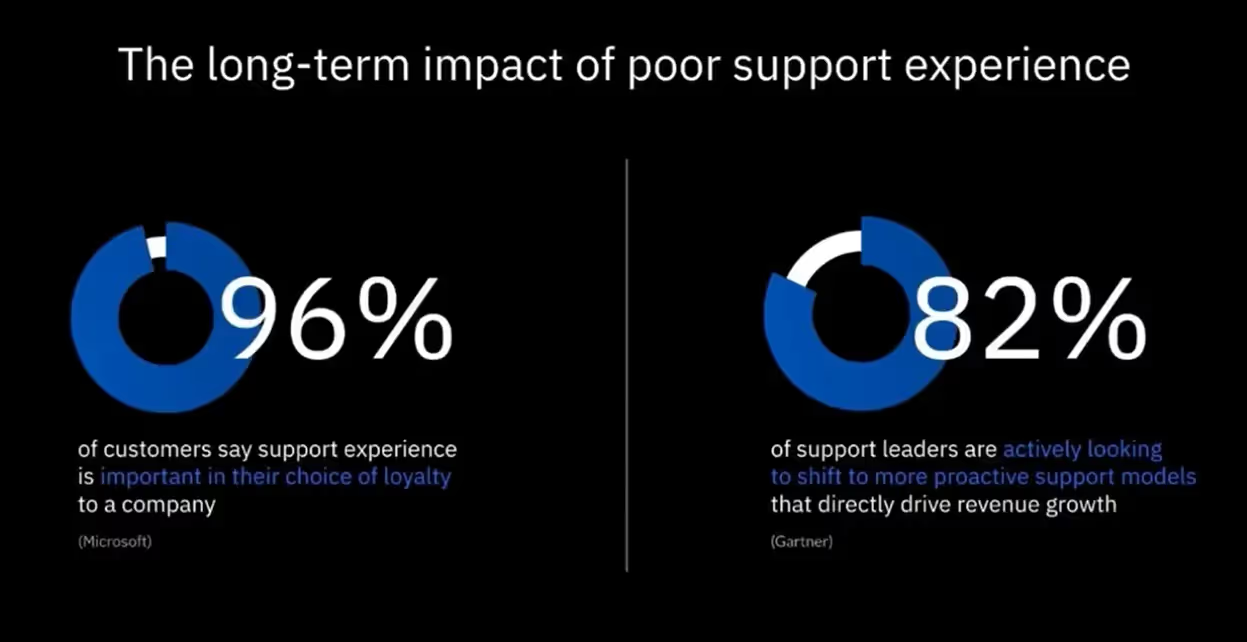
Companies need to be ahead of their support experience because it impacts all stages of the customer cycle. That’s because most product-led companies today make their support portal available to anyone –even people in a POC stage or those on a trial.
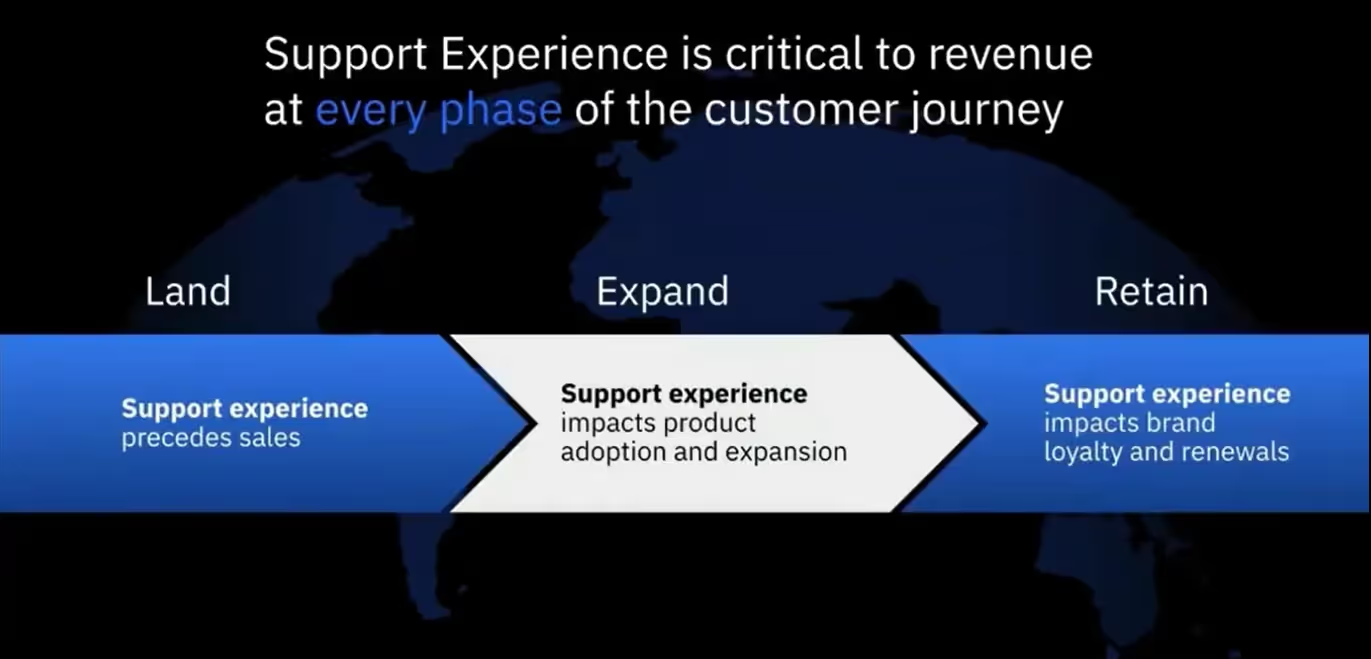
A tool like SupportLogic eliminates human bias, helps teams understand support signals from various sources, and extracts customer sentiment from support cases in real time. Rather than waiting for a support agent to figure out that something is wrong, it uses machine learning models to surface signals that can help you course-correct.
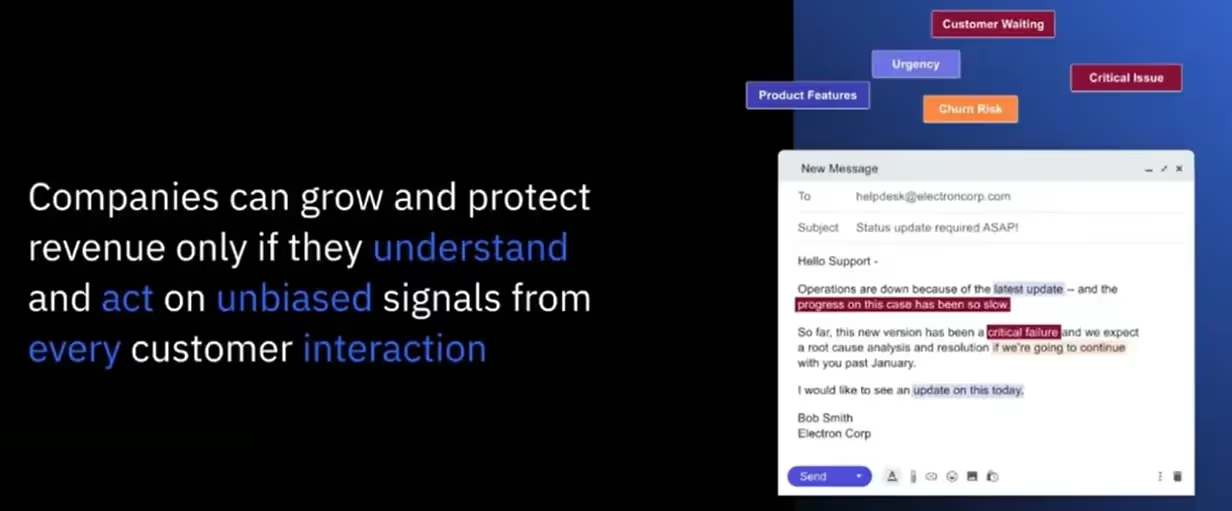
SupportLogic has found that companies focused on transforming their customer support experience can:
- Cut escalation rates by 50%
- Add an hour to their support manager’s days
- Monitor 100% of cases across all channels
- Increase CSAT and decrease handling time during spending freezes
- Reduce churn by 25% and upsell support tiers
The key is to track customer sentiment on an ongoing basis to identify customers that are likely to churn, and engineer a better experience, which in turn leads to better NRR.
You might also like
- The ultimate guide to client onboarding in 2023
- Propel23: Building the business case for investing in client onboarding
- Selling the value of your professional services
- A 5-stage customer onboarding process and flow chart (with templates)
- Champion Engagement Model: Best practices for identifying your customer champion


